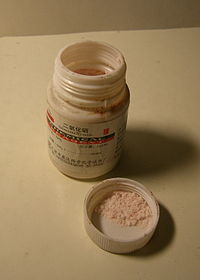- Selenium dioxide
-
Selenium dioxide 

 Other namesSelenium(IV) oxide
Other namesSelenium(IV) oxide
Selenous anhydrideIdentifiers CAS number 7446-08-4 
PubChem 24007 ChemSpider 22440 
UNII 9N3UK29E57 
UN number 3283 RTECS number VS8575000 Jmol-3D images Image 1 - O=[SeH2]=O
Properties Molecular formula SeO2 Molar mass 110.96 g/mol Appearance White, yellowish white[1], or red[1] crystalline solid Density 3.95 g/cm3, solid Melting point 340 ºC (sealed tube)
Boiling point 315 °C subl.
Solubility in water 38.4 g/100 mL (20 °C)
39.5 g/100 ml (25 °C)
82.5 g/100 mL (65 °C)Solubility soluble in benzene Solubility in ethanol 6.7 g/100 mL (15 °C) Solubility in acetone 4.4 g/100 mL (15 °C) Solubility in acetic acid 1.11 g/100 mL (14 °C) Vapor pressure 1.65 kPa (70 ºC) Acidity (pKa) 2.62; 8.32 Structure Crystal structure see text Coordination
geometrytrigonal (Se) Hazards MSDS ICSC 0946 EU Index 034-002-00-8 EU classification Toxic (T)
Dangerous for the environment (N)R-phrases R23/25, R33, R50/53 S-phrases (S1/2), S20/21, S28, S45, S60, S61 NFPA 704 Flash point Non-flammable Related compounds Other anions Selenium disulfide Other cations Sulfur dioxide
Tellurium dioxideRelated selenium oxides Selenium trioxide Related compounds Selenous acid  (verify) (what is:
(verify) (what is:  /
/ ?)
?)
Except where noted otherwise, data are given for materials in their standard state (at 25 °C, 100 kPa)Infobox references Selenium dioxide is the chemical compound with the formula SeO2. This colorless solid is one of the most frequently encountered compounds of selenium.
Contents
Properties
SeO2 is a polar molecule, with the dipole moment pointed from the midpoint of the two oxygen atoms to the selenium atom. Solid SeO2 is a one-dimensional polymer, the chain consisting of alternating selenium and oxygen atoms. Each Se atom, which is pyramidal, bears a terminal oxide group. The relative stereochemistry at Se alternates along the polymer chain (syndiotactic). The solid sublimes readily. The vapour has an odour resembling horseradish sauce and can burn the nose and throat on inhalation. Gaseous selenium dioxide adopts a bent structure very similar to that of sulfur dioxide. Dissolution of SeO2 in selenium oxydichloride give the trimer [Se(O)O]3.[2] Whereas SO2 tends to be molecular and SeO2 is a one-dimensional chain, TeO2 is a cross-linked polymer.
SeO2 is considered an acidic oxide: it dissolves in water to form selenous (selenious) acid. Often the terms selenous acid and selenium dioxide are used interchangeably. It reacts with base to form selenite salts containing the SeO2−
3 anion. For example, reaction with sodium hydroxide produces sodium selenite:- SeO2 + 2 NaOH → Na2SeO3 + H2O
Preparation
Selenium dioxide is prepared by oxidation of selenium by burning in air, nitric acid or by reaction with hydrogen peroxide, but perhaps the most convenient preparation is by the dehydration of selenous acid.
- 3 Se + 4 HNO3 + H2O → 3 H2SeO3 + 4 NO
- 2 H2O2 + Se → SeO2 + 2 H2O
- H2SeO3 ⇌ SeO2 + H2O
Occurrence
The natural form of selenium dioxide, downeyite, is a very rare mineral. It is found in only a very few burning coal dumps.[3]
Uses
Organic synthesis
SeO2 is an important reagent in organic synthesis. Oxidation of paraldehyde (acetaldehyde trimer) with SeO2 gives glyoxal[4] and the oxidation of cyclohexanone gives cyclohexane-1,2-dione.[5]. The selenium starting material is reduced to selenium, and precipitates as a red amorphous solid which can easily be filtered off.[5] This type of reaction is called a Riley oxidation. It is also renowned as a reagent for "allylic" oxidation,[6] a reaction that entails the conversion
- R2C=CR'-CHR"2 + [O] → R2C=CR'-C(OH)R"2
(where R, R', R" are alkyl or aryl).
As a colorant
Selenium dioxide imparts a red colour to glass: it is used in small quantities to counteract the blue colour due to cobalt impurities and so to create (apparently) colourless glass. In larger quantities, it gives a deep ruby red colour.
Selenium dioxide is the active ingredient in some cold-blueing solutions.
It is also used as a toner in photographic developing.
References
- ^ a b http://msds.chem.ox.ac.uk/SE/selenium_dioxide.html
- ^ Holleman, A. F.; Wiberg, E. (2001), Inorganic Chemistry, San Diego: Academic Press, ISBN 0-12-352651-5
- ^ American Mineralogist 62: 316–320. 1977. http://www.minsocam.org/ammin/AM62/AM62_316.pdf.
- ^ Ronzio, A. R.; Waugh, T. D. (1955), "Glyoxal Bisulfite", Org. Synth., http://www.orgsyn.org/orgsyn/orgsyn/prepContent.asp?prep=CV3P0438; Coll. Vol. 3: 438
- ^ a b Hach, C. C. Banks, C. V.; Diehl, H. (1963), "1,2-Cyclohexanedione Dioxime", Org. Synth., http://www.orgsyn.org/orgsyn/orgsyn/prepContent.asp?prep=CV4P0229; Coll. Vol. 4: 229
- ^ Coxon, J. M.; Dansted, E.; Hartshorn, M. P. (1988), "Allylic Oxidation with Hydrogen Peroxide–Selenium Dioxide: trans-Pinocarveol", Org. Synth., http://www.orgsyn.org/orgsyn/orgsyn/prepContent.asp?prep=CV6P0946; Coll. Vol. 6: 946
External links
Selenium compounds Categories:- Selenium compounds
- Photographic chemicals
- Acidic oxides
Wikimedia Foundation. 2010.

